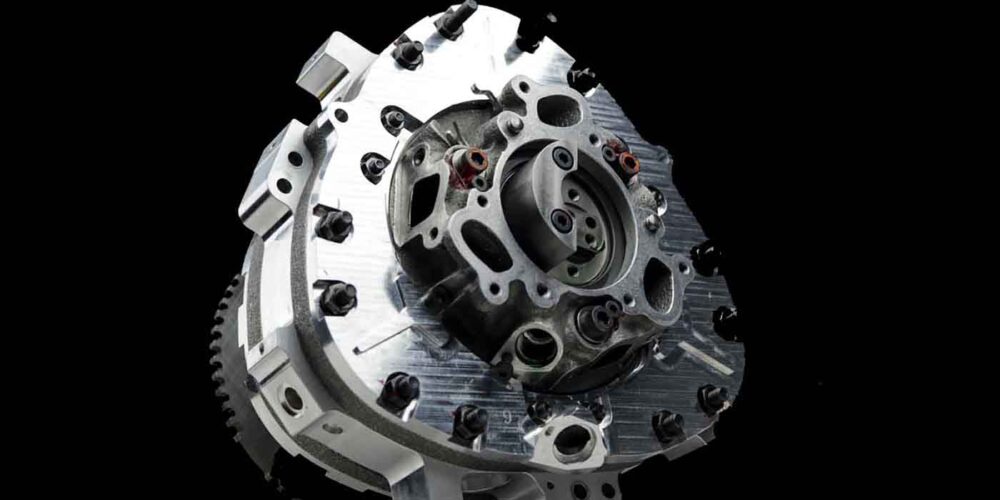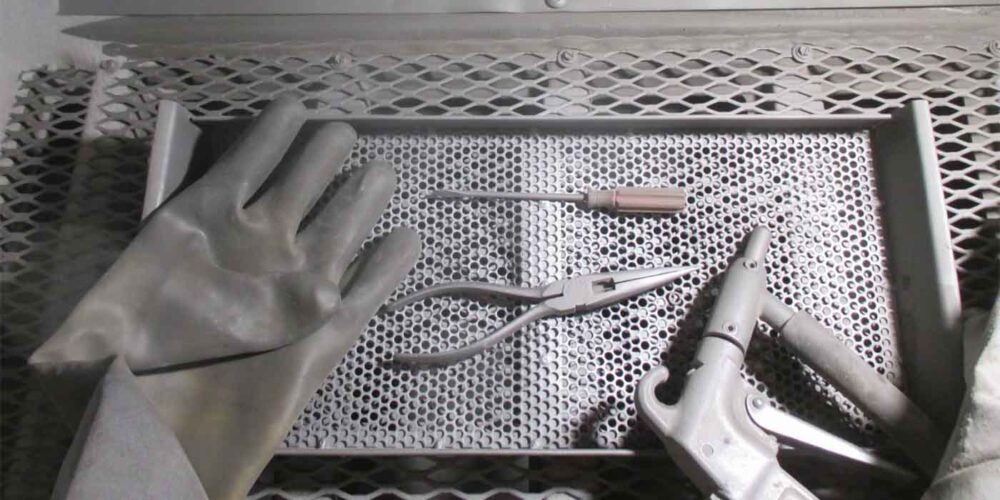Imagine the impact if we could make a new engine. One that is five times smaller and lighter than a traditional piston diesel with the efficiency of a fuel cell, and one that can support a variety of fuels – both traditional options (like gasoline and diesel) and cleaner alternatives (like sustainable aviation fuel or hydrogen).
At first blush this might sound like a pipe dream. With traditional engine designs, it’s exactly that. The reality is that the piston engine has been around for over 100 years. The Wankel rotary engine took a shot at displacing the piston engine some decades ago. However, its elegant architecture is hamstrung by issues with fuel efficiency, fuel type limitations, lubrication, emissions, durability, etc.
That’s unacceptable for the vehicles and power systems we need to create an efficient and sustainable future. But, what if we could design a new rotary engine that addresses these limitations without violating the laws of physics? This is what LiquidPiston has been working at for over a decade.
Our reimagined rotary engine – the X-Engine – solves the problems inherent to conventional alternatives. It’s a high-efficiency, low-emissions, multi-fuel-capable design that’s easy to customize for any application. It’s lightweight, compact and well-balanced at high speeds. That makes the X-Engine well-suited for hybrid electric and generator applications.
In this feature, I’ll lay out how LiquidPiston built the X-Engine, the problems it solves, and the technology being used to optimize its performance.
To reimagine the engine, we started with thermodynamics. Piston and traditional rotary engines still rely on the Otto and Diesel thermodynamic cycles, which haven’t changed effectively since the late 19th century. Engineers have found ways to boost engine performance, lower production costs, and reduce emission. But, without further innovation in the fundamental thermodynamics of converting fuel energy to work output, there remains a ceiling to high-impact improvements.
Enter the High Efficiency Hybrid Cycle (HEHC): LiquidPiston’s new, patented thermodynamic innovation. It combines elements of the Otto, Diesel, and Atkinson cycles to convert the same fuel energy into additional shaft work (see Figure 1). The three key components include:
- A high compression ratio: Highly compressed air mixes with fuel before injection and compression ignition (CI). (The cycle also works with spark ignition [SI], but using a lower compression ratio.)
- Constant-volume combustion: A dwell near top-dead-center allows fuel combustion to occur at a near-constant volume.
- A large expansion ratio: After fuel combustion, the resulting gas has room to overexpand and boost thermal efficiency.
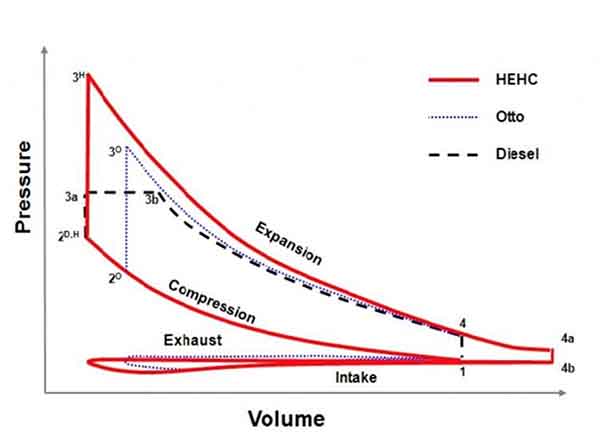
The HEHC cycle raises the ceiling for engine efficiency improvements, but conceptualizing the cycle was only the first step. In order to realize its potential, we needed a compact, power-dense engine architecture that could operate on this new cycle – and overcome legacy models’ problems without compromising on size, weight, or efficiency.
Next, we did something radical by turning the Wankel engine inside out. I noted earlier that the Wankel rotary engine contains some inherent design compromises that have limited the engine’s widespread adoption. There are still clear benefits, though – a high power-to-weight ratio, high responsiveness, and low vibration (thanks to the absence of reciprocating parts).
We wanted to design a new rotary engine that preserved these advantages while avoiding the compromises, hence turning the Wankel engine inside out.
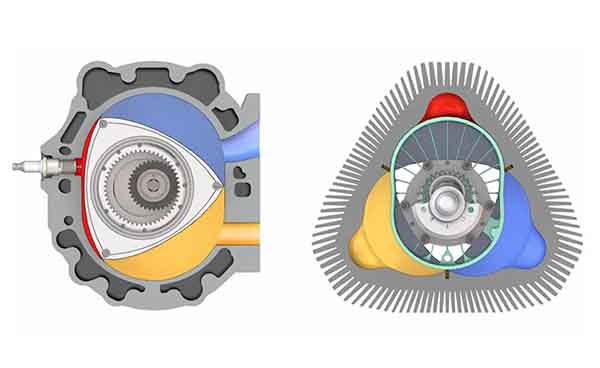
It sounds deceptively simple, but the resulting X-Engine is a dramatic rethinking of rotary engine architecture that enables the realization of the HEHC cycle. The effect is powerful – greater fuel efficiency, lower carbon emissions and extended durability.
1. Stationary Combustion Chamber → Greater Fuel Efficiency
The Wankel engine’s rotating combustion chamber makes it difficult to maximize fuel efficiency. For starters, it’s difficult to inject fuel due to the chamber’s constant motion. The fuel also doesn’t burn completely; the chamber’s long, narrow shape extinguishes the flame before it can consume fuel near the walls. And it’s geometrically impossible to drive the compression ratio high enough to optimize thermal efficiency. Given the math and shapes involved, rotor interference with the trochoid housing imposes a hard limit on the compression ratio.
The X-Engine’s geometry solves each of these problems. The combustion chamber is fixed within the engine’s housing, making it easier to directly inject fuel and avoid wall wetting. The combustion chamber can also be shaped at will to optimize fuel mixing, and combustion of the target fuel type(s), and it can be made smaller to drive a high compression ratio, which achieves greater thermal efficiency.
The bottom line? With a redesigned combustion chamber, the X-Engine architecture allows vehicles and power systems to use the HEHC cycle and achieve greater fuel efficiency.
2. Stationary Apex Seals → Easier Lubrication with Less Oil
Because the Wankel engine’s apex seals are installed in the rotor (which moves at a high speed), lubrication requires a combined air and fuel charge. But only a tiny fraction of the injected oil reaches the seals. The balance is wasted or burned, which creates an emissions challenge.
The Wankel geometry also requires small gaps between corner and face seals. These gaps create pathways for blow-by gas to escape and let unwanted sump oil into the combustion chamber.
Combine these problems with the seals’ high-speed movement, and only a fraction of the oil ever reaches its intended destination. This is more than a frustration because poor lubrication leads to premature engine maintenance – or worse, total engine failure.
To tackle these issues, we fixed the X-Engine’s apex seals within the stationary housing instead of the rotor. This design change keeps seals stationary, which eliminates centrifugal forces and makes them easier to lubricate. It also enables direct oil injection to optimize targeting, which in turn keeps oil out of the combustion chamber to reduce emissions and oil consumption. It also reduces blow-by, as the apex seals now interface directly with the face seal with no gaps.
Thanks to the X-Engine’s improved apex seal design, engineers can design the engine to meter the exact lubricant required to minimize internal friction and keep the engine running smoothly.
3. Greater Fuel Efficiency → Lower Emissions
Because the Wankel engine combustion chamber design doesn’t enable complete fuel combustion, it also emits more unburnt hydrocarbons. This is compounded by the apex sealing issues noted above: when oil gets burned in the combustion chamber, it further increases emissions.
The low compression ratio, coupled with challenges in blow-by, surface area, and combustion efficiency, ultimately results in reduced efficiency compared to a piston engine. Efficiency is inversely proportional to carbon emissions.
In contrast, the X-Engine’s improved combustion and sealing addresses the root causes of the Wankel’s high CO and HC emissions. The upgraded cycle efficiency directly improves the carbon emissions. For companies wary of going all-in on electric power, lower emissions could make X-Engine-powered hybrid electric vehicles an attractive and affordable way to protect the environment.
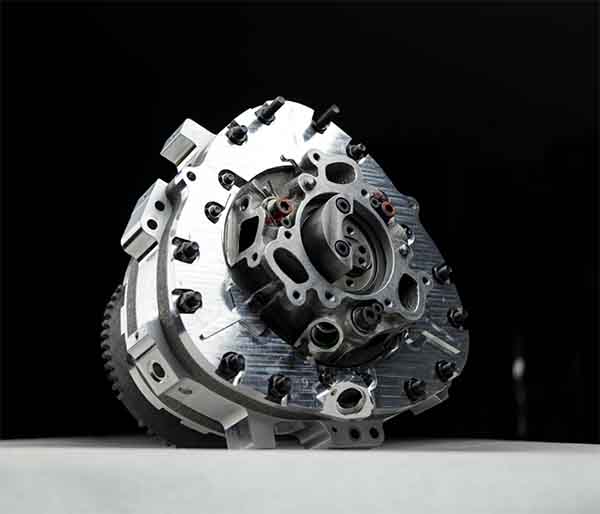
The X-Engine is powerful on its own, but it’s also a platform that’s easy to build on. We partner with our customers to build the best engine for their needs.
For instance, we can design either two- or four-stroke engines depending on whether a customer wants to maximize fuel efficiency (which is best for many applications) or power density (which is key when powering, for example, unmanned aerial vehicles).
Customers can also choose an ignition system (CI or SI) based on their desired fuel type and engine size. What’s more, our engines can run on multiple fuels. To date, we’ve tested diesel, gas, kerosene, jet fuel, propane, hydrogen, and even high-proof vodka (trust us, it works).
This multi-fuel capability is exciting for practically every industry. But we’ve seen a particularly large impact on aerospace manufacturers and the US Department of Defense.
Aerospace manufacturers need jet-fuel-compatible engines with lower kW ratings (i.e, less than 400 kW) for smaller aircraft propulsion (including hybrid electric and auxiliary power) that are more efficient than the turbines currently on the market. These engines also need to be compact enough to “earn their weight” on board.
The Department of Defense, meanwhile, has a single-fuel mandate that requires all vehicles and generators to operate on jet fuel as efficiently as possible. This way, it can minimize the logistics burden for a globally deployed force that’s constantly on the move. The problem: although today’s diesel piston engines can be adapted to work on jet fuel, such engines are big and heavy.
Thanks to LiquidPiston, aerospace and defense leaders now have a jet-fuel-compatible engine that’s 5 to 10 times lighter than existing alternatives. Our recently announced XTS-210 is a two-stroke supercharged engine that can be SI or CI – and is currently optimized for heavy fuels (like jet fuel or diesel) and military-grade power systems.
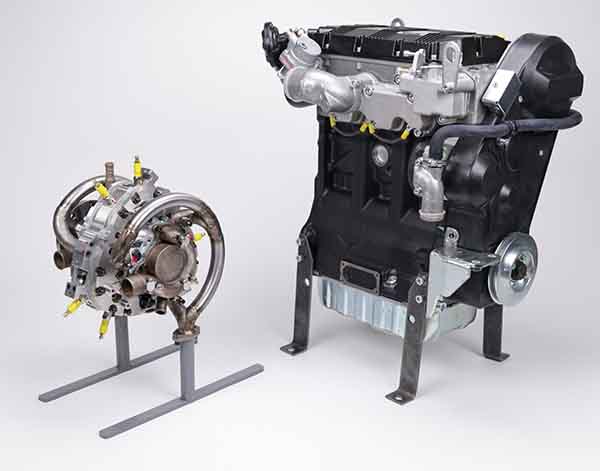
With more engines like this in use, more vehicles can run on low- or no-emission fuel types. This doesn’t just benefit our customers – at scale, this can go a long way towards helping the global clean energy transition.
The benefits highlighted here are just the beginning of a new era of fuel conversion technology innovation. To achieve this goal, we’re focused on continually optimizing our engine designs.
Before we build any prototype, our engineering team uses an on-site supercomputer to model and simulate millions of designs under a variety of operating conditions. Each physical test in our in-house laboratory improves the next simulation model, which reduces our design iteration time.
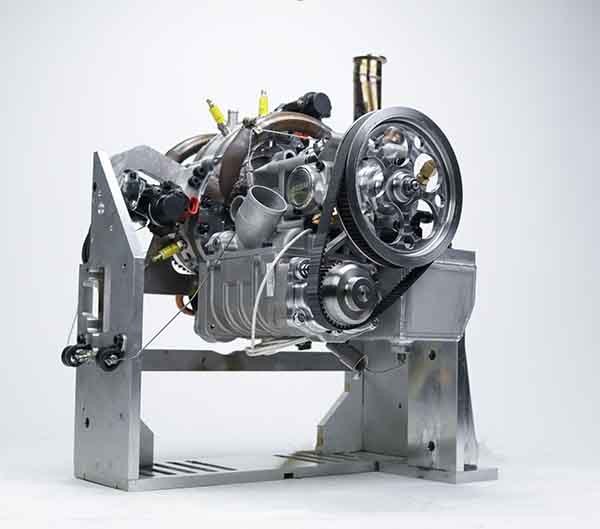
Thanks to this high-tech, iterative innovation process, LiquidPiston has had over 90 patents granted or pending. With each new engine design, we can deliver stronger performance to our customers and end users.
Rotary engines have had only limited commercial success, but that doesn’t mean all rotary engines are doomed. In fact, we’re on the cusp of the rotary engine 2.0 and much, much more.
With more engines like LiquidPiston’s, we could see a surge of new applications in everything from aircraft to hybrid electric vehicles, paving the way for a full rotary engine comeback. That’s a huge win for environmentally responsible economic development and the national security of the United States.
About the author: Alec Shkolnik is co-founder & CEO of LiquidPiston, which is a leading developer of compact and efficient power systems based on advanced thermodynamics, multi-fuel capable rotary engine technology, and integrated hybrid electric platforms. Alec has a PhD from MIT’s Computer Science and Artificial Intelligence Laboratory, where he was an NSF Graduate Research Fellow and a postdoctoral researcher.

